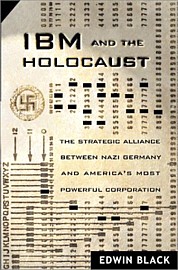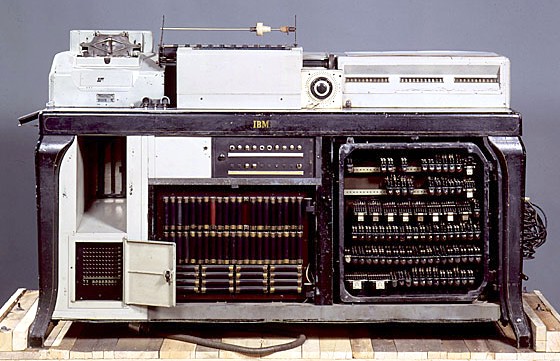Essay (back
to top)
Summary:
Edwin Black argues in his book, IBM and the Holocaust, that IBM not only supplied the Third Reich with punch card calculating machines to help automate several different aspects of its infrastructure, but also that these machines were used to automate the logistical side of the Holocaust. Black argues that IBM knew about this, and continued to supply the machines anyway. He goes on to argue that top level IBM executives, including CEO Thomas Watson, were aware of it, and played an integral part in the dealings with IBM subsidiaries in Nazi controlled areas and Switzerland. He argues further that Watson was not only aware of it, but actively participated, in the business partnership between Nazi Germany and IBM. This is very clearly true, as Hitler gave Watson a medal (Black, pg. 131). Watson did give the medal back once the United States and Germany were at war.
Before the United States went to war it is clear that IBM was actively doing business with the Nazis, which while reprehensible, was not uncommon. Once the United States went to war with Germany, it became illegal for American companies to do business with them. Black argues that IBM was still calling the shots for their German subsidiary, Dehomag, through their Swiss branch, which they were allowed to do business with. They not only operated in Germany, but also in all the occupied and collaborating countries (Black, pg. 389).
The actual business that IBM did with Germany was to lease them punch card tabulating machines to be used for census data, train schedules and other tasks. Black contends that IBM continued making these cards for Dehomag throughout the entire war, as they were the only ones that had the ability to. He goes on to say that during the war years IBM knew and actively engaged in business with Dehomag, which was under the control of a Nazi party member, who was also a loyal IBM man. Dehomag kept the profits earmarked to give back to IBM headquarters. Black argues that after the war was over IBM actively pursued this money knowing full well where it came from. They also recovered the machines which they had leased to many Axis controlled areas (Black, pg. 388).
IBM did not sell the tabulating machines, but rather leased them and had corporate support branches to do regular maintenance on the machines. These people who performed maintenance on the machines obviously had a much deeper understanding of what the machines were being used for. Once the war had started these people still kept their jobs with Dehomag, as did most of the other employees. Black asserts that IBM headquarters had a detailed understanding of what was going on and that their machines were being used to catalog the victims of the Holocaust. These machines had to be custom made, as did the punch cards, which had numerical values assigned to the different camps and methods of execution. So certainly some of the employees had a very good idea of what these machines were being used for.
Main Essay:
IBM and the Holocaust by Edwin Black addresses a very important and under-researched topic of corporate collaboration with the Nazis during the Second World War, and more specifically, involvement in the Holocaust. Edwin Black argues that IBM was deeply involved in the technological aspect of this, mainly by supplying and maintaining punch card tabulation machines to the Third Reich. According to him, IBM knew full well what they were doing to such an extent that he accuses the president of IBM, Thomas Watson, of knowing exactly what the machines were being used for. This seems somewhat difficult to believe, and Black does not do a very good job of proving his points throughout the book in general. The style of writing is also filled with hyperbole, which does not help the credibility. IBM certainly did a good amount of business with the Nazis before the United States entered the Second World War, but his points about IBM headquarters’ knowledge of the workings of the German IBM subsidiary, Dehomag, after that is on somewhat shaky foundations.
Much of the book focuses on Thomas Watson, the president of IBM during the 1930s and 40s. Black lays this out very early on: “But [Hitler’s] quest [to eradicate the Jews] was greatly enhanced and energized by the ingenuity and craving for profit of a single American company and its legendary, autocratic chairman…Thomas J. Watson” (Black, pg. 7). One reviewer of this book took issue with Watson’s treatment by Black, and points out several inconsistencies. One is a story about Watson sending a letter to Hitler stating his opposition to Hitler’s policies regarding the Jews in November of 1938, right after Kristallnacht. Essentially Watson sent Hitler this letter laying out his opposition to what was going on, and it came back unopened. A few months later the letter was resent (Black, pgs. 147-148). Black interprets this to mean that Watson purposefully misaddressed the letter, thus ensuring that he could go on record without actually having to have Hitler see it. This is an extremely cynical interpretation, and one for which he offers no evidence. The only citation for this is that the letter itself was mailed. Black also asserts similar motivations for Watson returning his medal that was given to him by Hitler, which Black erroneously claims was created specifically for Watson (Turner, pg. 638). He very publicly sent back his medal to Hitler, which was “the highest form of insult to der Führer” (Black, pg. 217). Watson did not need to do this, as other prominent Americans, such as Charles Lindberg and Henry Ford, did not. Watson alienated the Nazis a great deal with this move, and almost lost control of Dehomag. IBM’s machines in France were seized by the Nazis since they felt that Watson was no longer their partner (Black, pg. 226). Black concludes that these were all planned so that Watson could look innocent while still doing business with the Nazis. While that is possible, Black brings up no solid evidence to back up his theory.
According to Black, the Nazis would have not been able to carry out the Holocaust without the help of the IBM tabulating machines. This is a huge overstatement. Certainly automation can help speed up the process of genocide, but the Nazis were certainly able to obtain information about who was Jewish without having to look at census data. Black maintains that nearly all of the lists of Jews were made using census data tabulated by IBM punch card machines, but German laws forced Jews to come in and get new passports that had markers that very clearly indicated who was Jewish. Many went in without having to be told, and registered themselves voluntarily so as not to get into trouble. Also, as reviewer Michael Allen points out, many of the lists and files were tallied and done by hand, using more traditional methods of cross referencing files and using hash marks to tally lists, rather than machines (Allen, pgs. 152-153). While Nazi Germany undoubtedly used the tabulating machines, Black presents the use of them as near exclusive in terms of how the Nazis were able to so effectively identify and round up Jews; this is certainly an overstatement. According to the same review, Götz Aly and Karl Heinz Roth, holocaust historians whom Black cites, mechanization of statistical records only came after 1942, when Albert Speer began to push for it (Allen, pg. 153). This would have been after IBM was no longer allowed to trade with Dehomag or Germany, and Black does not conclusively prove that IBM NY had any knowledge of what their machines were being used for.
There is really no smoking gun type evidence that IBM NY did know what their machines were being used for after 1941, or that they were actively pursuing business with Nazi Germany after 1941. While it is certainly clear that IBM was actively pursuing business up until nearly the outbreak of war, it becomes far less clear that they still controlled their subsidiary, Dehomag, during the war. Black writes about an investigation carried out by the United States government at the very beginning of the war into whether or not IBM was violating the Trading with the Enemy Act. No information was found, and the investigator, H.J. Carter, did not find anything, and thus he concluded that the smoking gun records must be in Geneva (pg. 342). While this is plausible, no evidence is presented to back up this claim, the only citations are from Carter’s report, and it seems that he is just stating his opinion on the matter, rather than basing it on any documentation. IBM was never put on the list of pro-Nazi businesses, and was actively involved in the US war effort against the Third Reich, in fact they told the US military intelligence everything they knew about their overseas subsidiaries in enemy territories in order to help in the war (Black, pgs. 349-350). Black argues that this is even more damning, as IBM was playing both sides, but again produces very little evidence for this. During the war, IBM released many memos to “its managers in neutral Europe to repossess machines, stop trading with subsidiaries in enemy countries, and terminate contracts with blacklisted firms” (Black, pg. 393). He then claims that these were falsified to create a paper trail leading away from their true motives. Again, this all rests on very flimsy evidence; the citations that the documents were falsified leads back to some internal IBM memo that is not reproduced; no quotes are used either. This seems to be Black’s opinion, especially considering that the claims are not backed up by excerpts from the IBM memos which he is quoting. If they were so damning, it would seem that he would put them in.
While it is certainly possible that IBM was a willing partner in the Holocaust, Black’s evidence is really not all that damning. IBM very clearly did business with the Third Reich, but once the US entered the war there is very little evidence that they were actively doing business with the Nazis. Reviews by historians in the field seem to be universally in agreement. According to Henry Ashby Turner Jr., a professor of modern Germany at Yale who has written books on big business in the Third Reich, IBM and the Holocaust has “defects that render it all but worthless as a historical study. Black’s argument that the ability of the Nazis to carry out the Holocaust rests entirely on the shoulders of IBMs punch card tabulation machines is at least an overstatement. It seems that they had no problem finding collaborators who would gather the Jews up for them in every country they were in. While they certainly used these machines a great deal later in the war, the evidence that IBM knew and was pushing for their use is simply not there.
|

